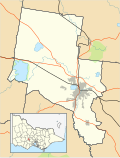A request that this article title be changed to Glendonald is under discussion . Please do not move this article until the discussion is closed. |
Glendonald | |||||||||||||
|---|---|---|---|---|---|---|---|---|---|---|---|---|---|
 | |||||||||||||
| Coordinates: 37°21′03″S143°50′31″E / 37.3509°S 143.8420°E | |||||||||||||
| Country | Australia | ||||||||||||
| State | Victoria | ||||||||||||
| City | Ballarat | ||||||||||||
| LGA | |||||||||||||
| Government | |||||||||||||
| • State electorate | |||||||||||||
| • Federal division | |||||||||||||
| Population | |||||||||||||
| • Total | N/A (2021 census) [1] | ||||||||||||
| Postcode | 3364 | ||||||||||||
| |||||||||||||
Glendonald is a locality on the Northern rural fringe of the City of Ballarat municipality in Victoria, Australia. At the 2021 census, Glendonald did not have a population able to be recorded. [1]
Helen Elizabeth Gillan, a leading campaigner for women, was born here in the 1870s. [2]

